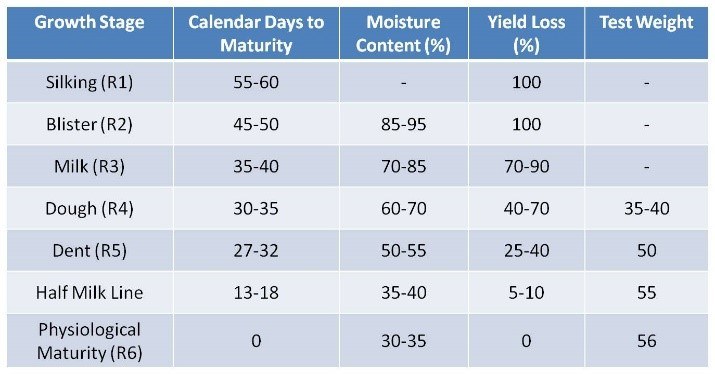Estimating Yield and Physiological Maturity

Producers and agronomists should be assessing each grain corn field now for yield estimates. Pollination is long since complete and we have an excellent idea of how many kernels have been pollinated.
The following is taken from Dr. R.L. (Bob) Nielsen on estimating corn grain yield prior to harvest. Dr. Nielsen has some excellent articles on corn production that are worth looking into. (www.agry.purdue.edu/ext/corn/news/timeless/YldEstMethod.html)
- At each estimation site, measure off a length of a single row equal to 1/1000th acre. For 30-inch (2.5 feet) rows, this equals 17.4 linear feet.
TIP: For other row spacings, divide 43,560 by the row spacing (in feet) and then divide that result by 1000 (e.g., [43,560 / 2.5] / 1000 = 17.4 ft).

Figure 1. Row length required to measure 1/1000th acre in various row widths – Ontario Grain Farmer (ontariograinfarmer.ca/2017/06/01/cropside-corn-stand-checkup/)
- Count and record the number of ears on the plants in the 1/1000th acre of row that you deem to be harvestable.
TIP: Do not count dropped ears or those on severely lodged plants unless you are confident that the combine header will be able to retrieve them. - For every 5th ear in the sample row, record the number of complete kernel rows per ear and average number of kernels per row. Then multiply each ear’s row number by its number of kernels per row to calculate the total number of kernels for each ear.
TIPS: Do not sample nubbins or obviously odd ears, unless they fairly represent the sample area. If row number changes from butt to tip (e.g., pinched ears due to stress), estimate an average row number for the ear. Don’t count the extreme butt or tip kernels, but rather begin and end where you perceive there are complete “rings” of kernels around the cob. Do not count aborted kernels. If kernel numbers per row are uneven among the rows of an ear, estimate an average value for kernel number per row. - Calculate the average number of kernels per ear by summing the values for all the sampled ears and dividing by the number of ears.
EXAMPLE: For five sample ears with 480, 500, 450, 600, and 525 kernels per ear, the average number of kernels per ear would equal:
(480 + 500 + 450 + 600 + 525) divided by 5 = 511 - Estimate the yield for each site by multiplying the ear number (Step 2) by the average number of kernels per ear (Step 4) and then dividing that result by a kernel weight “fudge factor”. Unless your seed company can provide some insight into kernel weight values for their hybrids, I suggest simply performing separate calculations using “fudge factor” kernel weight values equal to 75, 85, and 95. This range of values probably represents that most commonly experienced in the central Corn Belt.

Figure 2. Grain corn yield estimate formula – Iowa State University (crops.extension.iastate.edu/cropnews/2017/08/estimating-corn-yields-using-yield-components)
Example: Let’s say you counted 30 harvestable ears at the first thousandth-acre sampling site. Let’s also assume that the average number of kernels per ear, based on sampling every 5th ear in the sampling row, was 511. Using “fudge factor” values of 75, 85, and 95; the estimated range in yield for that sampled site would (30 x 511) divided by 75 = 204, or divided by 85 = 180, or divided by 95 = 161 bushels per acre.
Repeat the procedure throughout field as many times as you deem representative. Tally and average the results separately for each “fudge factor” used for the calculations.
Remember that this year we have very uneven uniformity in most corn fields, which will influence the accuracy of any yield estimation technique. The less uniform the field, the greater the number of samples that should be taken to estimate yield for the field.

Figure 3: Measurements for each reproductive stage of corn development and how a killing frost would affect yield at that stage.
In early September, we tend to estimate when the corn will reach physiological maturity even more than we estimate yield in each field. In recent years, Manitoba has been getting early to mid-September killing frosts, so the chart above has been a very well-used reference. If you need help determining stage of corn, visit Grain Fill Stages in Corn (Purdue University), or a simple Google search for countless resources on how to properly identify milk line or physiological maturity (black layer).
Article written by Morgan Cott, Agronomy Extension Specialist (Special Crops) with Manitoba Crop Alliance
